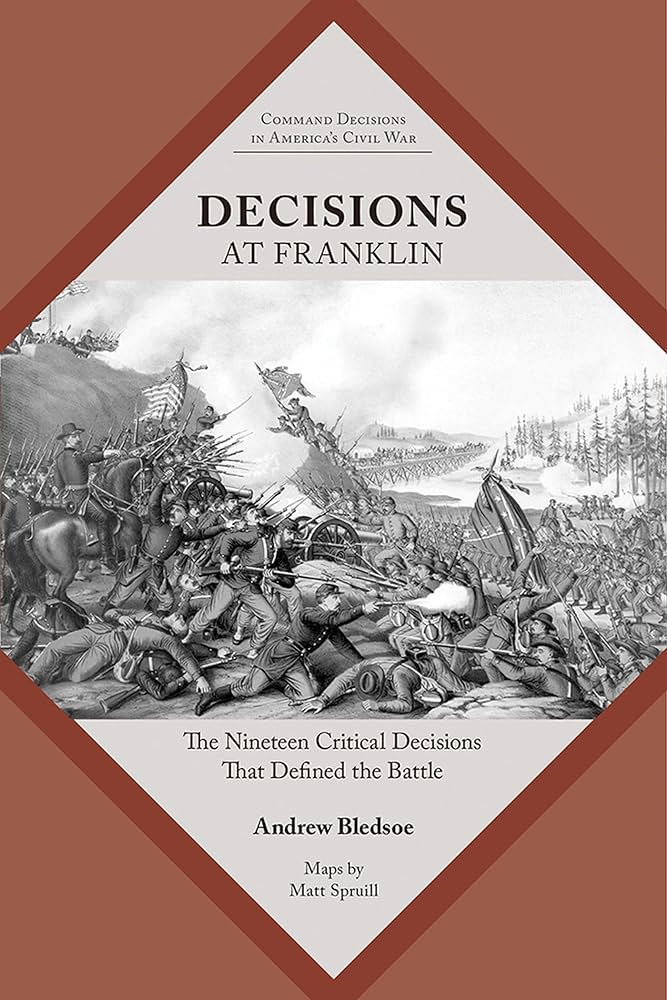Book Review: Decisions at Franklin: The Nineteen Critical Decisions That Defined the Battle

 Decisions at Franklin: The Nineteen Critical Decisions That Defined the Battle. By Andrew S. Bledsoe. Knoxville: The University of Tennessee Press, 2023. Softcover, 280 pp, $29.95.
Decisions at Franklin: The Nineteen Critical Decisions That Defined the Battle. By Andrew S. Bledsoe. Knoxville: The University of Tennessee Press, 2023. Softcover, 280 pp, $29.95.
Reviewed by Lee White
Decisions at Franklin: The Nineteen Critical Decisions That Defined the Battle by Dr. Andrew S. Bledsoe is a recent addition to The University of Tennessee Press’s ever-expanding “Command Decisions in America’s Civil War” series. The battle of Franklin, and the 1864 Tennessee Campaign as a whole, are particularly well suited for this type of study as both are rife with persistent myths and counterfactual debates among students of the battle.
As the book’s subtitle indicates, Bledsoe presents readers with nineteen decisions that he considers to be the most defining moments of the campaign and covering events leading up to and during the bloody November 30, 1864, Middle Tennessee engagement. This volume, like the other works in the series, presents the various situations requiring decisions, offers potential options, provides what the decision ultimately was, and then gives readers the final decision’s result and its impact.
As mentioned briefly above, Spring Hill and Franklin are fights rich with opportunities for questioning the decisions that both the Federals and Confederates made. The campaign and battle decisions that Bledsoe chooses to explore and discuss within the book are those readers will appreciate and that students of the battle often discuss. And while all of the books in the series offer thought provoking situations and “what if-style” options to consider, this one stands out because of Bledsoe’s choices. Some of the decisions he examines are broad, such as should Schofield have made a stand at Franklin and why Gen. John Bell Hood decided to attack. Others are more nuanced, like Gen. Jacob Cox allowing a small gap in his defense where the Columbia Turnpike passed through the Federal lines, and Schofield’s decision to withdraw after repulsing all of the Confederate attacks.
Perhaps due partly to the amazing reclamation work presently happening at the largely developed battlefield, Franklin and the events leading up to it have enjoyed a recent surge in interest. Much of the current scholarship on the battle focuses on challenging many of the die-hard myths and misconceptions surrounding it and its aftermath. Bledsoe’s work fits in perfectly here and makes a fine companion study to Eric A. Jacobson’s definitive account of the battle, For Cause & For Country: A Study of the Affair at Spring Hill and the Battle of Franklin. Both help students of the battle understand what happened, what did not, and most importantly, why.
As is the common practice with the Decisions series books, Decisions at Franklin also includes a driving tour in the appendices. And like the other Decisions books, the tour that Bledsoe offers is not one that looks at what happened and where, but rather this tour guides visitors to the points where the Union and Confederate commanders made their decisions. In doing so it allows the tourist to view the terrain from the decision maker’s point of view. In addition, the tour includes appropriate excerpts from the commanders’ Official Records reports as well as other supplemental materials and maps. These put the tour taker into the boots of those making the critical decisions and help one understand what they were thinking at the time. The appendices also include orders of battle for both armies. End notes, a bibliography, and a thorough index round out the book.
Although Decisions at Franklin may not be the best choice for introductory learners, well-versed students and those who have at least some basic understanding of what transpired at Spring Hill and Franklin will find it thought-provoking and insightful.